Last Updated on: September 1, 2025Frustrated by floodlights that corrode and fail? You chose aluminum for durability, but it didn’t last. Discover the hidden quality secrets that ensure true long-term performance.
Aluminum is a top choice for LED floodlight housings due to its excellent heat dissipation, durability, and corrosion resistance. High-quality aluminum, like A380 die-cast, ensures the LEDs stay cool and the fixture withstands harsh weather, significantly extending the product’s lifespan and reliability.
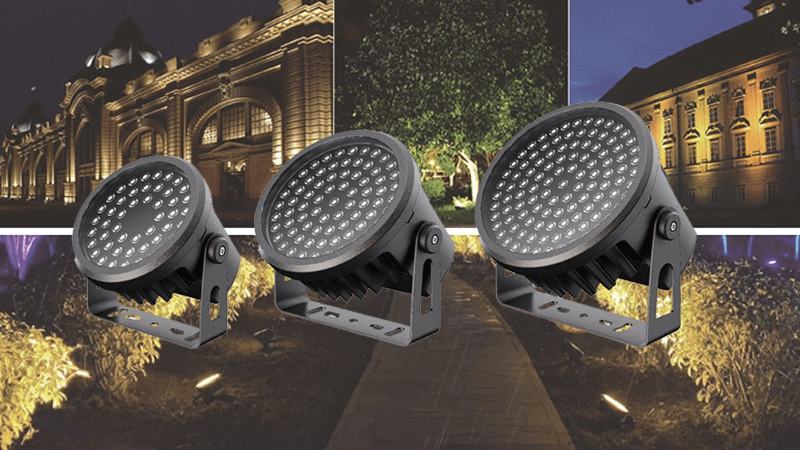
Choosing aluminum seems like a simple, smart decision. But not all aluminum is created equal. In my years in this industry, I have seen how small differences in material and manufacturing can lead to huge problems for buyers like you. I have worked with many purchasing managers, like Shaz from the UAE, who need to trust that their suppliers are delivering on their promises. Let’s break down what really matters. You need to know these details to protect your projects and your investment.
Is aluminum a good material for outdoor lights?
Choosing materials for outdoor lights feels like a gamble against the elements. A poor choice leads to rust and failure. True aluminum is your best bet for durability.
Yes, aluminum is an excellent material for outdoor lights. Its natural oxide layer provides great corrosion resistance. When properly treated with anodizing or powder coating, it can withstand extreme weather, UV radiation, and salty air, making it ideal for long-lasting, reliable outdoor lighting fixtures.
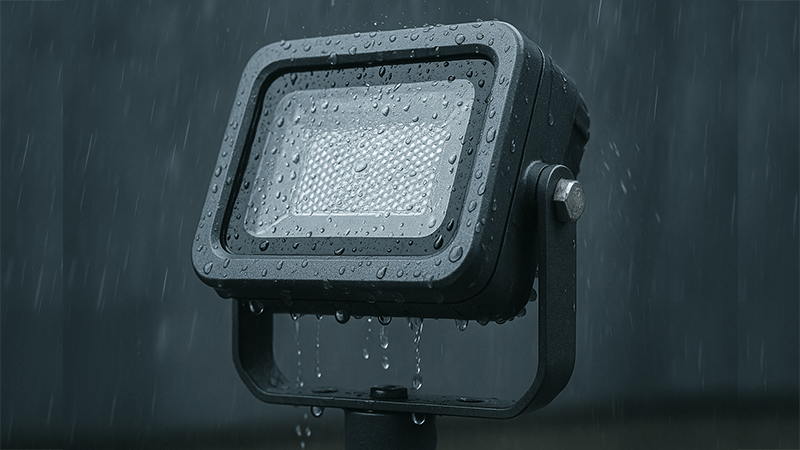
When you are sourcing outdoor lights for a major project, you need to be sure they will last. Aluminum is the go-to material for its inherent strength and light weight. But the real reason it excels outdoors is its resistance to corrosion. However, this is where many suppliers cut corners, and buyers get burned. You must look deeper than just the words "die-cast aluminum" on a spec sheet.
The "Die-Cast" Deception
Many suppliers will tell you they use die-cast aluminum, which is true. But they fail to mention the grade of aluminum they use. Many use ADC12, which is essentially a recycled aluminum. It contains many impurities, which makes the final product more brittle and prone to cracking under stress or impact. More importantly, these impurities create weak points that allow corrosion to start much faster, especially in salty or humid environments. I once helped a client who discovered his new floodlights were cracking after just one season. The root cause was the supplier used cheap ADC12 aluminum. For true durability, you should insist on a higher quality alloy like A380 aluminum. It has superior purity, thermal performance, and corrosion resistance.
The Myth of "All-Aluminum" Construction
Another common trap is the "all-aluminum" lie. A supplier may provide a fixture with a thin aluminum housing, but the critical components are made of cheaper materials. We have seen it countless times. The mounting bracket, the screws, and even the internal supports are made from plain iron. These parts are the first to fail. As soon as they are exposed to moisture, they begin to rust. This rust then streaks down the fixture and the wall, making a brand new installation look old and neglected. Worse, the rusting bracket can lead to structural failure, causing the light to sag or fall. A truly high-quality outdoor light will use stainless steel (like SS304) for all hardware to prevent this exact problem.
| Feature |
True High-Quality Fixture |
Common Low-Cost Fixture |
| Housing Material |
A380 Die-Cast Aluminum |
ADC12 Recycled Aluminum |
| Screws/Hardware |
Stainless Steel (SS304/316) |
Iron or Zinc-Plated Steel |
| Bracket |
Thick, Powder-Coated Aluminum |
Thin Iron, Painted |
| Result |
Long-Term Durability, No Rust |
Early Failure, Rust Streaks |
Why is aluminium batten used in LED lights instead of plastic?
Wondering why your plastic-housed LEDs burn out so fast? The heat they generate has nowhere to go, slowly cooking the electronics. Aluminum solves this by acting as a heat sink.
Aluminum is used over plastic in LED lights primarily for thermal management. LEDs generate significant heat, and aluminum is an excellent conductor. It acts as a heat sink, drawing heat away from the LED chips and dissipating it into the air, preventing overheating and ensuring a long lifespan.
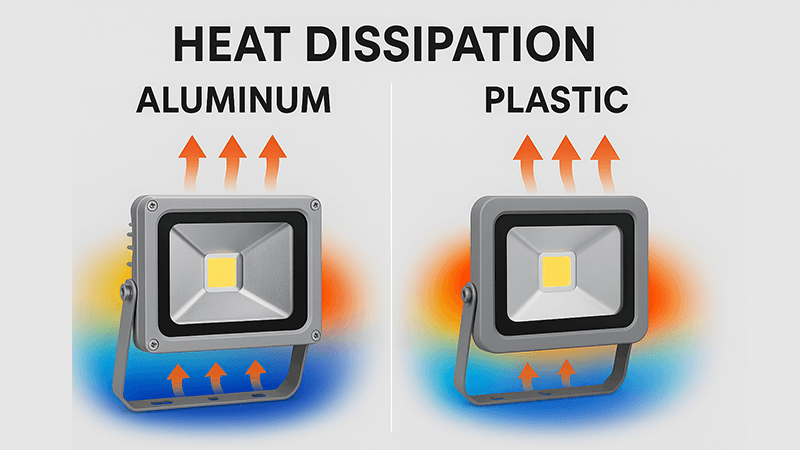
The single biggest enemy of an LED chip is heat. While LEDs are very efficient, they still convert a portion of electricity into heat. If that heat is not managed properly, the LED’s performance will degrade, its color can shift, and its lifespan will be drastically shortened. Plastic is a thermal insulator. It traps heat around the electronics. While some "thermally conductive" plastics exist, their performance is nowhere near that of aluminum. This is why aluminum is not just an option, but a necessity for any high-power LED light. But even here, manufacturers have developed tricks to save money that compromise performance.
The Wall Thickness Trick
A key factor in a heat sink’s performance is its mass and surface area. Some manufacturers create a housing that looks thick and robust from the outside. But if you cut it open, you will find that the actual wall thickness is very thin. They use internal reinforcement ribs to provide some structure, but the overall amount of aluminum is minimal. This is a deliberate tactic to reduce material costs. A thinner housing has less mass to absorb and conduct heat away from the LED driver and chips. This can lead to the fixture running much hotter than it should, silently killing the light from the inside. When you inspect a sample, feel the weight. A quality fixture with proper wall thickness will feel substantial and solid, not light and flimsy.
The Importance of Genuine Materials for Heat
The grade of aluminum also impacts thermal performance. Pure aluminum is an amazing thermal conductor. But as impurities are added, like in recycled ADC12, its ability to conduct heat can be slightly reduced. While the structural weakness is the bigger problem, every aspect of performance matters. When you combine thin walls with a less-effective aluminum alloy, you get a housing that is not doing its job. The LEDs will run hot, and the product will fail early. This is why a simple specification like "aluminum housing" is not enough information. You need to know the alloy and verify the physical construction to ensure you are getting the thermal performance your project requires.
What are the advantages of using aluminium?
You specify aluminum for its durability, but the finish fails within a year. The coating peels, and the surface chalks. The secret to longevity lies in the surface preparation and materials.
The key advantages of aluminum are its high strength-to-weight ratio, excellent thermal and electrical conductivity, and natural corrosion resistance. It is also highly recyclable and can be easily formed into complex shapes, making it an ideal material for efficient and durable LED light housings.
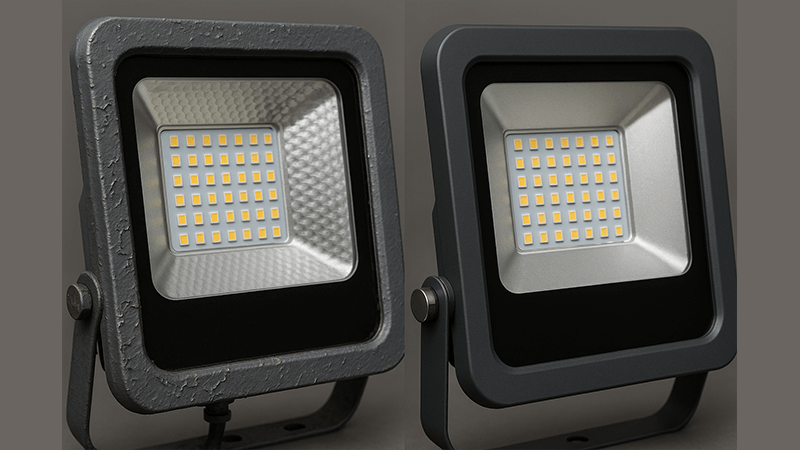
Aluminum offers a fantastic combination of benefits. It is strong but not heavy, which makes installation easier and safer. It can be die-cast into complex housing designs with integrated heat sink fins. And it naturally resists rust. But these amazing advantages can be completely undone by poor surface treatment. The finish on an outdoor light is not just for looks; it is the first line of defense against the environment. Unfortunately, this is one of the easiest places for a factory to cut corners. As a purchasing professional, you need to be aware of how they do it.
The Anodizing Thin Film Trap
Anodizing is a great process that thickens the natural, protective oxide layer on aluminum’s surface. A thick anodized layer is very hard and extremely resistant to weather and UV radiation. The trap is that a supplier can claim their product is "anodized" even if the layer is incredibly thin. For proper outdoor and coastal protection, the anodized layer should be at least 15 micrometers (μm) thick. Many low-cost producers apply a flash coating that is less than 10μm. This will look good when it comes out of the box, but after a year or two in the sun, it will begin to fade and "chalk," turning into a white powder. It offers almost no long-term protection.
The Powder Coating Shortcut
Powder coating is another excellent and common finish for aluminum lights. When done correctly, it provides a thick, durable, and attractive coating. But there are two main shortcuts that lead to failure. First is the use of cheap, low-grade powder. These powders have poor UV resistance and will fade and become brittle quickly. The second, and more common, shortcut is skipping the pre-treatment process. Before powder coating, the aluminum must be properly cleaned and chemically treated (e.g., chromating). This process etches the surface on a microscopic level, which gives the powder something to grip onto. Without proper pre-treatment, the powder coating has poor adhesion and will start to peel or flake off, exposing the bare metal underneath.
| Process Step |
High-Quality Process |
Low-Cost Shortcut |
| Pre-Treatment |
Multi-stage chemical cleaning & chromating |
Simple wipe-down or skipped entirely |
| Powder |
High-grade, exterior-rated polyester powder |
Cheap, interior-grade epoxy/polyester mix |
| Curing |
Cured at precise time & temperature |
Inconsistent temperature, shortened time |
| Result |
Strong adhesion, >5 years durability |
Peeling, flaking, fading in 1-2 years |
Why is aluminium good for lamps?
Sourcing a lamp that is tough, lightweight, and cool-running is a challenge. Many materials fail at one of these. Aluminum is the one material that does it all.
Aluminum is good for lamps because it serves as both the protective housing and the essential heat sink. This dual function allows for designs that are compact, lightweight, and highly effective at dissipating heat, which is critical for the performance and longevity of the internal LED components.
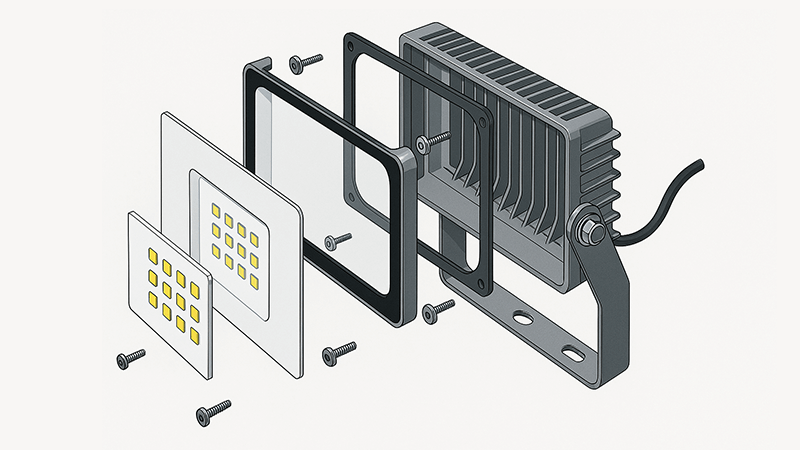
The beauty of aluminum for lamps is its ability to perform multiple jobs at once. For an LED floodlight, the housing is not just a box to keep the rain out. It is an active and critical part of the thermal system. Using aluminum allows designers to create a single, integrated part that is both the strong outer shell and the finned heat sink. This simplifies manufacturing, reduces the number of parts, and creates a more efficient path for heat to escape. This synergy is what makes aluminum the superior material. But everything depends on the quality you, as the buyer, demand and verify.
Verifying True Quality
As a purchasing manager like Shaz, you cannot rely only on datasheets. You must ask critical questions and inspect the products. First, demand material specification sheets that clearly state the aluminum alloy is A380 or an equivalent high-grade alloy, not ADC12. Second, ask for reports on the surface treatment. This could be a salt spray test report (which simulates corrosion over time) or a report confirming the thickness of the anodizing or powder coating. When you get samples, inspect them closely. Are the screws stainless steel? Does the fixture feel solid and heavy for its size? You can even try to scratch the coating in a hidden spot to check if it flakes off easily. These simple checks can reveal the lies that datasheets hide.
The Long-Term Value Proposition
I always advise my partners to think about the Total Cost of Ownership, not just the initial purchase price. A fixture that is a few dollars cheaper because it uses ADC12 aluminum, iron screws, and a poor finish is not a bargain. That fixture will fail. It will lead to warranty claims, labor costs for replacement, and damage to your company’s reputation. A high-quality fixture made with A380 aluminum and a proper, thick surface treatment might cost slightly more upfront. But it will perform reliably for years, protecting your investment and your reputation. As I always say, do not just look at the price on the invoice. Look at the price of failure. That is where the real cost is.
Conclusion
In summary, choosing aluminum is just the first step. True durability comes from verifying the alloy grade, construction integrity, and surface treatment quality to ensure long-lasting performance.